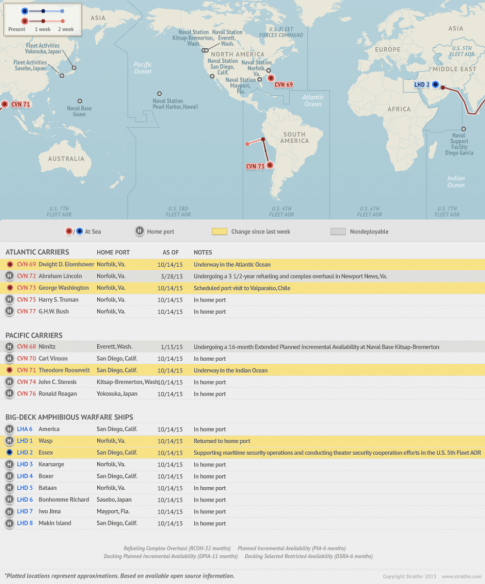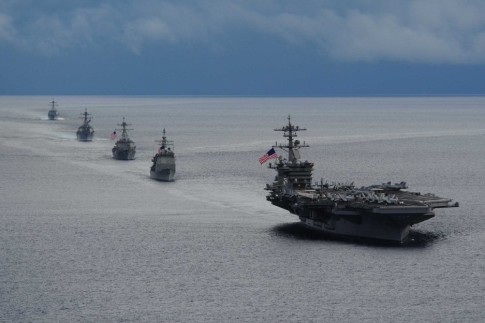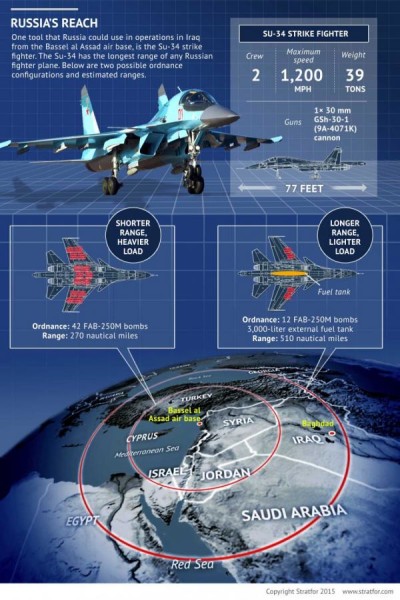– Obama Withdraws Aircraft Carrier Support From Middle East Just As Russia Unveils Its Syrian Airbase:
One glance at the map below, showing the current distribution of U.S. naval assets, reveals something that has almost never happened at any time in the past decade:

As the map shows, US aircraft carrier, CVN 71 Theodore Roosevelt is currently on its way out of the Persian Gulf, leaving just the LHD-2 Essex Amphibious Warfare ship group to defend the Persian Gulf and more importantly, leaving the hotly contested middle east without U.S. carrier-based air support for the first time in years.

How did this happen?
According to USNI News, the Theodore Roosevelt Carrier Strike Group left U.S. 5th Fleet on Tuesday with no public timeline for when its replacement will reach the Middle East to continue U.S. air strikes against Islamic State in Iraq in Syria (ISIS) targets. While the CVN 71 The Harry S. Truman Carrier Strike Group is slated to be the next CSG bound for the Middle East, but the Navy would not specify a deployment time other than later this year, a service official told USNI News on Tuesday.
“We’re not going to talk to future operations,” the official said.
That said, the redeployment of the Roosevelt is not a surprise: two months ago the CNN Pentagon correspondent warned that this was coming:
The U.S. Navy will not be able to keep an aircraft carrier in the Persian Gulf for much of the fall season, according to a Navy official. The official said that’s because the Navy has to schedule needed maintenance after years of extended deployments and because of reduced spending due to mandatory budget cuts.
While there have been so-called “carrier gaps” in the Persian Gulf before, this one will leave the Navy without the presence of a high-profile aircraft carrier just as a proposed nuclear deal with Iran is at center stage. It also comes as Iranian naval forces have conducted low-level harassment of U.S. and other shipping in the region.
U.S. military officials insisted that there would be no impact on U.S. operations in the gulf because the Air Force can briefly send additional, land-based aircraft to the region if needed. Airstrikes against ISIS targets in Iraq and Syria are also largely undertaken by the Air Force. The Navy accounts for only about 20% of the ISIS strike missions.
Whatever the reason, the Roosevelt is out of there, and the ship is now said to be bound for its new homeport at Naval Station San Diego, Calif.
While in 5th Fleet, the Roosevelt CSG was the largest symbol in the U.S.-led anti-ISIS collation responsible for “1,812 combat sorties totaling 10,618 combat flight hours, taking on 14.5 million gallons of jet fuel and expending 1,085 precision-guided munitions,” as part of Operation Inherent Resolve, according to a Tuesday statement from the service.
Which probably does not explain why in over a year, the US did less damage to ISIS then the Russian airforce has achieved in less than a month.
As for the reason why suddenly the Persian Gulf has an unprecedented US carrier support gap in the middle east – one which could last for two months or well longer – it is because the Harry S. Truman Carrier Strike Group, which is slated to be the next CSG bound for the Middle East, has been delayed and the Navy would not specify a deployment time other than later this year, a service official told USNI News on Tuesday.
Earlier this month the Truman CSG completed its Composite Training Unit Exercise (COMPTUEX), the complex training exercise that certifies the strike group for deployment.Previous CSG and three-ship Amphibious Ready Group deployments were often extended to meet the demand of U.S. geographic combatant commanders (COCOMs) at the expense of maintenance setbacks and crew fatigue.
Furthermore, this may be just the beginning of key US naval “gaps” across critical geographic regions:
As the Navy continues to implement stricter deployment tenants, more gaps in Middle East carrier presence may emerge, several service leaders told USNI News in September. Last month Rear Adm. Jeffrey Harley, assistant deputy chief of naval operations for operations, plans and strategy (OPNAV N3/5B) told the House Armed Services Committee (HASC) that it would take a directive from the Secretary of Defense to the Navy to extend the deployment of a carrier to longer than seven months.
While extending a carrier is always an option, another option would be “to reduce our global input as to what we can provide [to the combatant commanders] for a designated period of time, and mitigate that presence, that carrier presence, in some other way using our joint partners, using joint aircraft to cover a gap in time in which we may not have a carrier present,” Harley told the panel.
Whatever the future of US naval “gaps” may be, one thing is clear: the departure of the Roosevelt comes at a particularly awkward time – just as Russia is set ting up its own aicraft base in Syria.
As we reported yesterday, “The start of Russian airstrikes in Syria has given new hope to loyalist forces in their battle against a host of rebel factions, including the Islamic State. Now Russia may expand these operations into Iraq if requested to do so by Baghdad. Indeed, from its position in Latakia, Russia has the range to strike Islamic State targets in Iraq, although further deployment of resources may be required to do so effectively.”
More importanly, Russia can now also reach the all important global “choke point” of the Suez Canal within minutes, not to mention Tel Aviv, Jerusalem, Baghdad, and – if propertly equppped – Bahrain, the headquarters of the U.S. Fifth fleet.

In conclusion ,we take one final look at the map up top, and ask if on its way back to San Diego the Roosevelt will be the ship that Obama uses to send China a message as he has threatened to do, by sailing around the contested islands in the South China Sea, a move which China has warned twice it will be forced to retaliate against. Recall that yesterday China’s Global Times said that should Obama carry this out, it would be a “breach of China’s bottom line”.
“If the US encroaches on China’s core interests, the Chinese military will stand up and use force to stop it,” the paper warned.
In light of this upcoming showdown, one hopes that the USS Rosevelt won’t be known in history as the second coming of the USS Maddox.
Very interesting.
Could it be part of the really big plan, or based on something as trivial but potentially embarrassing as Russia’s proven ability to ‘kill’ all weapons systems from a single jamming plane, rendering a big monster CVN dead in the water?
This is of interest too.
I wonder just ‘who’ these ‘foreign run training camps’ are run by?
Four options. US/CIA, UK/SAS, israeli/mossad & the French FL/Secret Service.
My money’s on the whole lot of ’em.
http://www.almanar.com.lb/english/adetails.php?eid=234541&cid=23&fromval=1&frid=23&seccatid=20&s1=1